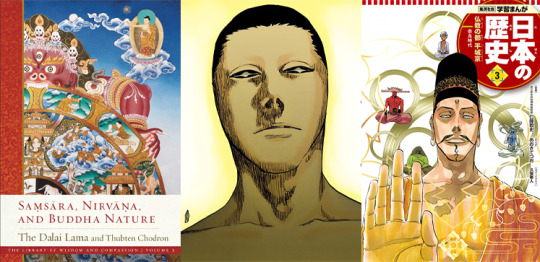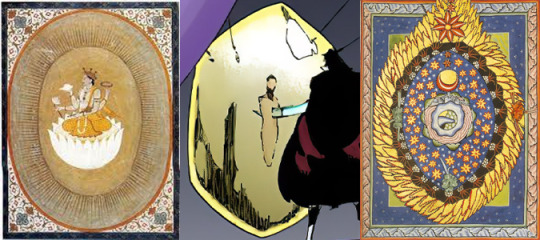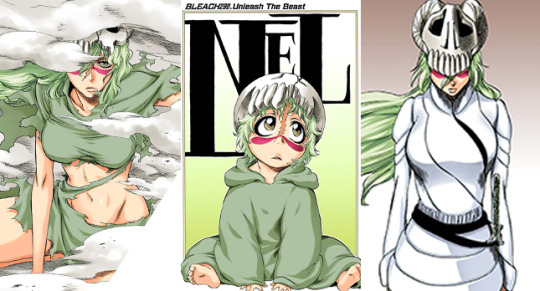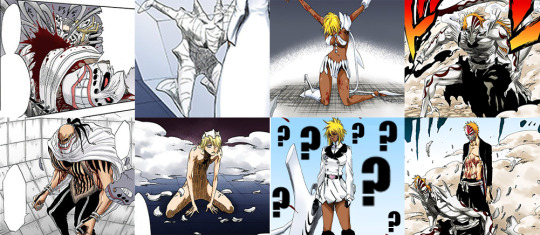#and yarn and corkboard web weaving
Explore tagged Tumblr posts
Text
today i'm just wrangling all my weird loose ends and crackpot theories. Stuff that doesn't actually have enough evidence to support it, or that I just personally headcanon or that just doesnt go anywhere or come back again often enough to really derive any meaning or implications from. stuff i can't really justify making individual posts on, so im making a post about how unpostable they are collectively
warning: long, also warning: nonsense

So we know Bleach operates on a loose variation of the Buddhist samsara/rinne, the wheel of reincarnation, in which souls cycle through many lives in different forms, experiences hardships in life and the pain of loss and death continuously until/unless they can achieve enlightenment, as the first Buddha did, and in doing so escape the cycle of death and rebirth, ascending to a higher state of being in which life and death no longer apply. In traditional art of Buddhist cosmology this is represented by the Buddha being present off to one corner, literally physically outside the elaborate illustration of the wheel and its many facets(itself encompassed by the demon mara). This Buddha role is the figure the Spirit King occupies in the hierarchy of the Bleach cosmology, but there are a few little orbital details that are clearly related to that role, but as I stated in the preface to all this, never really go anywhere....


So there's this thing in Hinduism and by some association Buddhism (although it plays more into Hinduism's actual faith in the mythology of their gods, where as a lot of Buddhism may still invoke the divine but ultimately is about undermining and escaping the authority of said cosmological structure) called the Hiranygagarbha[हिरण्यगर्भः] "The Golden Womb"/"Golden Egg," or "Universal Womb"/"Primeval Womb," and is associated with various gods described as Svayambhu[स्वयम्भू] "Self Born," many of which are some variation on a/the creation god --effectively it's just the explanation that while everything comes from something, the original something had to have come from nothing, or else there's just an infinite number of questions that theologians would be forced to come up with infinite answers for.
But it posits that while something may have come from nothing, that something still had to follow certain understood notions of cause and effect, like incubation and birth. Ergo the creator god didn't just blink into existence fully formed, he was "born" from the nothing and as the first and initially only thing to exist he birthed himself. In these myths he is frequently described as initially existing either "beyond" or without senses --obviously the without senses bit mirror's YHWACH's origin, but to exist not without a capacity to see, hear, feel, etc... but in a place or state in which those senses cannot perceive also echo's Aizen's rambling about power levels as he rapidly ascends toward godhood before being beaten surpassed by Ichigo.
But beyond creation myths the Golden Egg is evoked in some elements of meditation in which each person, in their innate capacity for enlightenment and this divinity, has within them their own egg, and to retreat into that egg and explore the potential to self actualized as a mental act of birthing an ideal self, has overt parallels with Bleach's use of an inner world in which the zanpakutou spirit, a reflection of the self and of a potential for power, dwells.

Incidentally the egg also facilitates the creation of the world itself, one half of the discarded shell from the god's birth becoming the realm of the material and the other half becoming the realm of the celestial, and as per some rants I've been on before, between it and some questions about how zanpakutou really work, it reminds me very distinctly of a few other anime/manga where a god spirit's aura or range of influence, for which a lesser spirit's would normally sustain a single person, encompasses a domain in which the totality of other people's existences reside.
In addition the egg itself, a concept called Purusha that is at times a god and at times a concept, is in some myth the creator god in question in relation to the Golden Egg, born from said egg, and then thru their dismemberment by other gods, the world is molded. So obviously some pretty overt, if superficial similarities with the Spirit Kings lack of limbs and, yeah sure if we want to acknowledge it, the LN's feeble additions to lore.
But as a concept it represents self-awareness in the idea that there is a kind of Platonic ideal of the perfect awareness of everything that is in its definitive and empirical state that has become unknowable by the division of that primordial self-awareness, but which exists in fragments in all living things.
The quartering of the body is also the basis of the 4 castes in traditional Indian society; although that dismemberment is not specific to two legs and two arms like the Spirit King's.



But speaking of the spirit king's body parts, there's a neat thing going on with the design of his eyes that got weirdly ditched... In his original appearance the 4 solid black pupils were shown in top-bottom, and left-right orientation, but once he showed up again later, Kubo switched to a 4 corners sort of thing instead. At the time there was no Allmighty reveal and thus no established power of all-seeing yet, but in the eventual context of The Almighty and it manifesting in YWHACH's increased pupil count from 1 to 2 to 3, it becomes apparent that should he reach full potential he would have the same eyes as the Spirit King.
But then what capacity for all-seeing powers has the Spirit King really shown? Well, not a lot in practice, although YHWACH addresses the Spirit King as one who had at one point seen the future. But notably the original design, which had been scrapped and pushed entirely out of mind by the time any of these new contextual details were actually being written in, actually does seem to imply some faculty of all-sight in the Spirit King: The Gotei 13. Their insignia frame, which we typically see with a captain's associated squad number, is shown during an explanation of the Shihouin's Onmitsukidou, is its own symbol even without any numbers. And the insignia appears to be a stylized depiction of the Spirit King's all-seeing eye. Is the insignia itself some kind of magic sigil or artifact, or simply symbolic of a role the Gotei plays? Who can say.

Let's circle back to the Golden Egg though, because the anime changed its color to blue, almost matching the color and style of the generic Quincy spirit bows/arrows. But I personally always instinctively assumed it was a kind of golden hue; something the digital colorist clearly thought as well, which was gratifying. But I also assumed the coloration was something that matched a number of other things, and with very distinct meaning: Orihime's shields, Hacchi's barriers, and the Menos Grande's Negación beams. Before the Spirit King's crystal was even an issue to deal with, there was already a very conspicuous link,
Orihime and Hacchi have the same powers of Event Rejection
Hacchi's Rejection barriers stem from his Visored powers
Hacchi's barriers thus appear to be a more refined Negación
Orihime's powers are said to tread on the authority of God
With those implications in place, it seemed evident that part of the reason for the Spirit King's inertness and imprisonment in the stasis crystal was that thru some divine power, be it his own or someone else's, the crystal exists to reject events happen around/to him to preserve him in a particular state. And since we know it didn't seem to protect him from bodily harm, there would implicitly be a more important and perhaps abstract thing in mind being actively undone.
This in turn would have provided an adequate excuse for Orihime being unable to reject the crystal being broken, and the Spirit King's injuries within it, because as we learned from Hacchi; she has to understand what she's rejecting, and those powers are most potent when aimed at the abstract(an event) and not an object(an injury). For her to reject a rejection would mean understanding the nested abstract events taking place, which frankly no one was ever brought up to speed on, whether we're talking my theories here or the actual canon of the manga.
This I would have found much more acceptable than Kubo falling back on "Important character too strong, implicit functions of established powers don't work on him." Which is a bad habit Kubo has just in general; he never actually thinks out the implications of how world building on the plot he's writing, he just muscles thru it by making up new excuses, rather than going back into what he's already established to find interesting ways for preexisting abilities or factoids to interact. He very consistently fails to "yes, and..." himself.

Anyway... There's also a little followup on my persistent rambling about the nature of hollows and of the elusive Vastolorde. Until the revival one-shot just a few years ago, it was easy to forget about Hell in Bleach considering it never really came into play. But there was one interesting point made that hollows who have sinned in life go the hell, while the others are purified. Most hollows implicitly are just spirits of the dead overcome by powerful emotions, but their monstrous qualities aren't considered a sin, they're an animal-like instinct.
And this is addressed, if only barely, by Zommari's indignant rant against the moral authority of the Shinigami; that the natural way if things is to let hollows exist, but the shinigami invented the morality and ethics of "protecting" humans from hollows, and "purifying" hollows with zanpakutou. And we know from the example of someone like Nel that the Arrancar process returns a kind of human intelligence and morality to a Hollow, even across the process of individual spirits becoming hollows, amassing into colony minded Gillians, and then reemerging unique personalities as Adjuchas.

I still maintain the real/sensible trajectory of the Nel plot should have been that she was a Vastolorde, that Nnoitra was sent to hunt Vastolorde, but threatened by her and infuriated by her power tempered with human morality, was beat and spared but took a cheap shot to break her mask, effectively forcing her into being a mock-arrancar, like Isshin and Urahara discussed, and so Nnoitra reported back negative results on the hunt to guard his own position in the Espada. But in the face of being unable to find enough surviving Vastolorde, Aizen's plan would be to take existing mock-arrancar and have Orihime reject the event of their mask removal, so that he can remove it via the Hougyoku.
In this way I think Nel could have had her generic hot-girl-ification in a more sensible and satisfying way than magic cloud of smoke de-baby-fication. I think it also would have made for a cool reveal for Orihime's uniquely abstract event rejection --as opposed to time reversal-- to mean that although the process of her transformation would be undone, her experiences post break would not, thus she'd still remember Ichigo and be able to turn on Aizen and join the good guys accordingly.

Anyway, even without all that, Nel and her goofballs, and to a lesser extent Starrk and even Ulquiorra, and sort of Harribel, all prove that the Arrancar are capable of a pretty normal moral spectrum and aren't in fact just evil or monsters all the way down. In fact, it was always kind of present since Sora's chapter way back in the beginning. In fact, Sora was the first Hollow to be drawn with the now iconic double mouth, the prior two were just monsters. Sora however showed his human mouth behind the mask, and that was a feature that would carry forward from there. In fact, at the end of chapter 25 there is also the original arrancar hook, where we see Aisslinger perform surgery on GrandFisher. But while the main event is the removal of the mask, there's also the bodily surgery taking place that suggests that what would later be identified as the mock-arrancar process involves digging the humanoid back out from under not only the mask but the hollow's inhuman, bestial body as well.

This is in turn echoed when we see Wonderweiss born as an arrancar in a much cleaner process, but one not dissimilar to Grandfisher's; his wrapped hollow form, while generally humanoid --and thus implicitly a Vastolorde-- also clearly includes some large protrusions that are stripped away along with the majority of his mask. And as Uryuu relates from Urahara's briefings, the more human form also means more human intelligence. Along with the apparent moral fiber of the matter it really seems like when a hollow gets more human, it gets more human in almost all respects. (ignore that harribel bit in the image there, we'll come back to it...)
So what happens when they get the most human?

I've also gone over my whole thing before that the Nelgal Ruins seemed like the natural evolution of the architecture of the menos grande, lending yet another level of humanity to the hollows: society. More over, my crackpot headcanon that in the human development of the Vastolorde they discovered religion, and comprised the first cult of YHWCH.
Of note in this random line of thought is that fact that Lille Barro is considered to be the first Sternritter given a schrift. It's not clear if that means that the sternritter we know are considered contemporaries (even ignoring the confusing timeline of Juugram and Bazz-B's whole flashback) and among them Lille is the first among them, or if there have been prior generations of sternritter and Lille is as survivor of some batch of sternritter long predating the current recruiting push.

But there is the question of if Lille is an arrancar or not. He somewhat conspicuously speaks Spanish, although the Sternritter do have a loosely international shtick going on in their roster. But he also has a lot of design notes in common with Starrk, although it's super unclear if that's applicable to in world logic, or just a pattern in Kubo's art. The biggest hiccup in this would perhaps be that he has no signs of a mask fragment, but then the same went for Luders Friegen. Notably Asguiro Ebern still had a mask and Luders made a point to speak down to him. While we never got any clarification on that, I think it seemed like the superiority complex came from being less arrancar-like. And I wonder if there wasn't a process by which the Wandenreich were removing mask fragments in their entirety, resulting in a kind of forced and imperfect humanization process, but from which highly humanoid and thus Quincy-fiable arrancar could be produced.
And while the shot of Harribel was obviously just fanservicey battle damage, I like to think that the plan was to convert her, and that she was in the process of having her bone armor components stripped off, not unlike the process Grandfisher and Wonderweiss underwent: it resembles Wonderweiss' in posture, but Grandfisher's in bloody tortuous overtone.
Primitive Arrancar, without the ability to gain shinigami-like powers via the hougyoku, stripped of their masks might theoretically regain human intelligence, but would lose their masks and sense of self with no way of storing it in a sword let alone being able to retrieve it. What better subjects to manipulate with the promise of a discovery of self and of identity; drink of YWHACH's blood and receive the sense of self you lack. Something to fill that hole in your heart.

Then there's the thing I mentioned earlier about how there's some interesting implications about what it means to throw a bunch of spirits together into one superdense thing. And it turns out a lot of them seem to be pretty similar...
You throw shinigami souls together to make white, who is himself like an asauchi.
You throw i guess also shinigami(?) "something similar" together to get asauchi according to Oh-etsu
You throw powerful human spirits together and get the King's Key.
You throw hollows together and get a menosgrande
and if we care to dip a toe into the LN (which normally I would hesitate to do) we have at least one other zanpakutou, besides White, explicitly crafted from a menosgrande
and when the miracle baby reclaims quincy spirit power you get YWHACH
My supposition then is that the reason Vastolorde were so rare, and explicitly in hiding from Aizen, was that in the first place hunting menos is how the asauchi are created. The very first time we see a Gillian, Rukia even comments that it's the Royal Guard's job to take care of them, not regular shinigami. As the power scale of the series naturally escalates that begins to feel silly, but what if that's not because only the Royal Guard can defeat them, but because the Royal Guard and Oh-etsu in particular are uniquely suited to hunt/harvest them so they can be turned into new asauchi.

And in a way, if the Spirit King is indeed locked in a meditative state in his golden egg, if indeed the god sleeps in the egg, and the egg is the center of the world, and the world is the egg. If the world itself is the Spirit King's inner world, his bankai manifesting the internal as reality, then what is YHWACH if not the Spirit King's sword spirit? In the same way YHWACH is already a part of zangetsu within Ichigo. A reflection of the self, however dark, convinced that godhood is not in the Spirit King's best interest and determined to tear him from that throne? Is that not exactly what the fused Zangetsu tried to do in stopping Ichigo from learning the final getsuga and fighting Aizen? What is YHWACH's war on soul society but the struggle between two mirrored entities over who gets to stand at the top and who has to crawl around in the shadows?
What is the difference between a king and his horse?
#bleach meta#apocryphal meta#the meta meta?#just gibbering nonsense headcanon#and yarn and corkboard web weaving#it was already kinda unmoored to begin with#but i really lost track of where i was going somewhere in all this#so i just took the opportunity to end on a pretentious bleach quote when the chance presented itself
102 notes
·
View notes